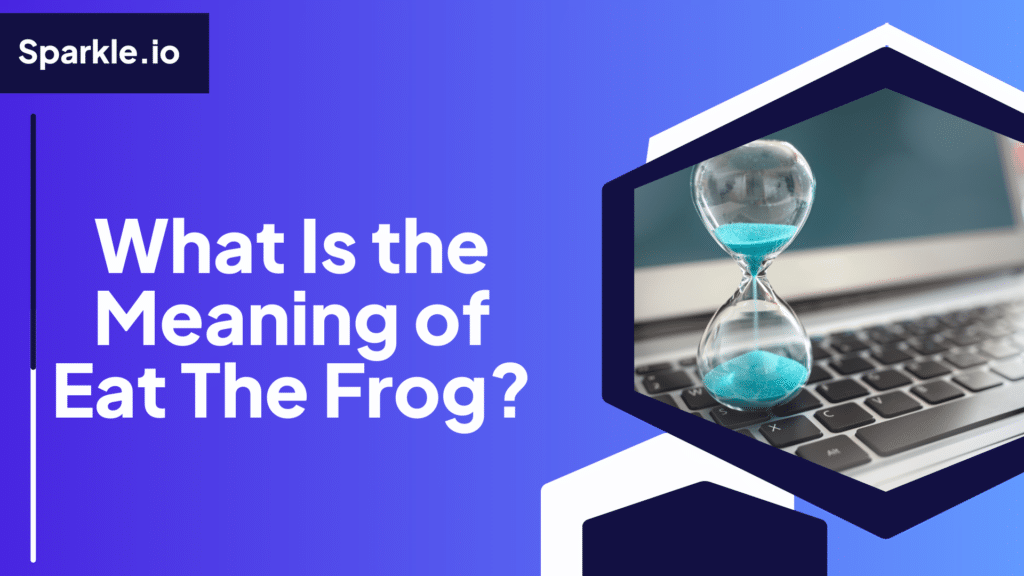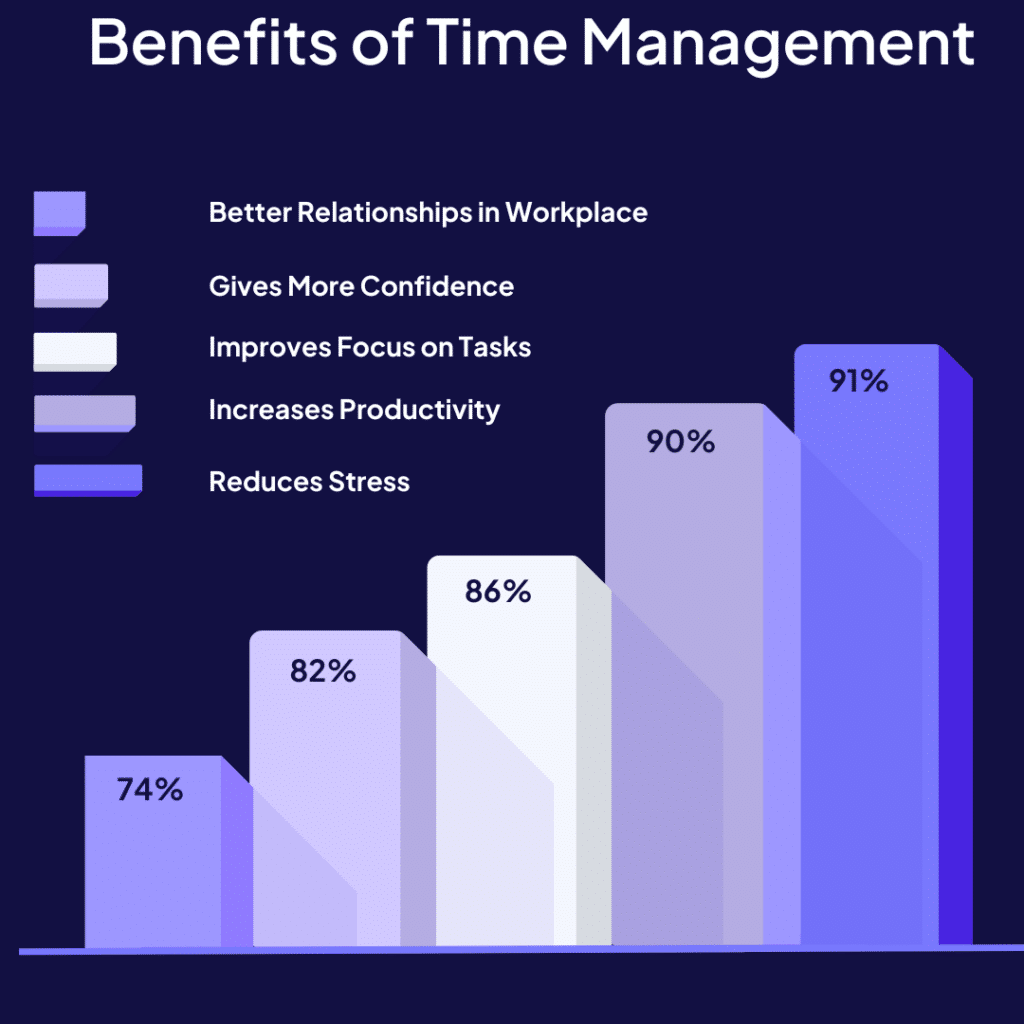
I know the title of the article pulled you in. Just to clarify, it’s more of a metaphorical expression rather than being taken literally.
You know that terrible feeling when you have a huge backlog of tasks due to delaying or getting distracted?
I’m sure you must have tried various ways. Few might have worked and few might not.
But what if I say there is a way to escape this cycle?
Trust me! Let’s eat the frog and break the chain.
Key Takeaways
- The “Eat the Frog” method is a productivity technique that recommends completing the most challenging or important task first thing in the morning. This approach aims to overcome procrastination, reduces stress, and sets a productive tone for the day.
- Effective implementation of the “Eat the Frog” method requires identifying critical tasks, prioritizing them, breaking them into smaller steps, creating a suitable work environment, minimizing distractions, and utilizing time management techniques such as the Pomodoro Technique and the Two-Minute Rule.
- Regular application of the “Eat the Frog” philosophy can result in increased productivity, reduced stress levels, better time management, improved focus, and personal growth. However, it is crucial to be mindful of potential drawbacks such as burnout, premature task switching, and possible negative impacts on creativity.
Table of Contents
What Does “Eat The Frog” Mean?
| Eat the Frog is a productive technique that encourages tackling the most challenging, important, or dreaded task of the day. |
This principle is a metaphor that stems from a famous quote by Mark Twain:
“If it’s your job to eat a frog, it’s best to do it first thing in the morning. And if it’s your job to eat two frogs, it’s best to eat the biggest one first.”
He inspired Brian Tracy, a productivity consultant to write the book Eat That Frog!: 21 Great Ways to Stop Procrastinating and Get More Done in Less Time. This book covers 21 principles to overcome procrastination and make each day productive.
Who Can Benefit from the Eat the Frog Productivity Method?
Wondering who might benefit from this? It’s obviously us.
People like us, do struggle with this fast-paced world of tasks. Letting stress, anxiety, and what not? Just take a deep breath, see where you stand in the following, and make the best use of the “Eat the Frog” philosophy.
Procrastinating on Important Tasks:
Till date, you must be holding on to one procrastinated work and no one can escape the trap of procrastination.
Is it that hard to escape the trap?
Earlier, I would have agreed, but now I’ve mastered the tactics.
I’ll explain it to you.
The “Eat the Frog” method helps overcome procrastination on critical tasks. By tackling your biggest, most challenging task at first, you get the hardest part out of the way early. This prevents putting it off and facing last-minute stress later.
Struggling to Prioritize the To-Do-List:
With multiple tasks popping around in a day, it is hard to prioritize the to-do list. When you have a daunting to-do list, “Eat the Frog” provides clarity.
It directs you to identify and tackle your most crucial, taxing task (the metaphorical frog). Accomplishing this, sets a productive tone and momentum for the rest of your priorities.
Feeling Like Not Making the Most of The Time:
I’m sure, not once but often you must have experienced this “Why on earth, I’m not able to make the most of my time?”
No worries, applying “Eat the Frog” ensures you dedicate your peak energy and focus to your most important work early in the day. This helps maximize productivity during your most alert hours.
How to Identify Frogs?
Before you can start “eating frogs,” it’s crucial to identify which tasks qualify as frogs in your daily business routine. Here are some common indicators:
Importance Over Urgency
True frogs are not just time-sensitive emergencies. They are activities that have the biggest positive impact on your team’s performance, revenue goals, or strategic objectives.
Replying to emails may feel urgent but contributes less than work driving key results.
Example Scenarios:
- Developing a targeted sales strategy targeting high-value customer segments.
- Conducting comprehensive market research to identify new opportunities.
The 80/20 Principle (Pareto Principle)
Brian Tracy, the author who popularized the “Eat the Frog” method, was heavily influenced by the Pareto Principle. This principle suggests that roughly 80% of your results come from 20% of your efforts.
When identifying frogs, consider which tasks will contribute most significantly to your 80% most important goals.
Example Scenarios:
- 20% of your products generate 80% of your revenue. Focus marketing efforts on those products.
- 20% of your blog posts drive 80% of the traffic. Analyze top performers to replicate success.
Time-Intensive Efforts
Frog tasks typically require substantial time and focus to complete, often over an hour of work.
The ideal frog may be a 1-4 hour undertaking. For longer tasks, break them into separate frogs to tackle smaller tasks over multiple days.
Example Scenarios:
- Creating a detailed, customized sales proposal for a major client.
- Evaluating and implementing a new CRM system across the organization.
Psychological Resistance
You’ll likely face some mental hurdles with a true frog task. It could be something you’re dreading, feeling anxious about, or simply dislike doing.
If you catch yourself wanting to procrastinate on a particular task, that’s probably your frog.
Example Scenarios:
- Making cold calls to prospective clients, despite the fear of rejection.
- Negotiating challenging terms with a demanding client.
Requires Human Ingenuity
Frogs demand human effort, skill, and creativity. If it’s a routine task that can be automated or delegated to technology, it’s likely not a high-priority frog for your attention.
Example Scenarios:
- Developing creative upsell strategies for existing customers.
- Creating a unique value proposition for a new product or service.
Goal-Aligned Importance
A frog should be an activity that directly contributes to and aligns with your team’s key objectives, KPIs, or OKRs.
If a task doesn’t ladder up to driving important goals, it may not be your highest-priority frog.
Example Scenarios:
- Identifying and pursuing high-value leads aligned with ideal customer profiles.
- Optimizing the sales funnel to increase conversion rates and revenue.
How to Eat the Frog: 15 Core Principles
Now that you have understood the concept of “eating the frog” and how to identify your frogs, it’s time to delve into actionable strategies for effectively tackling these challenging tasks.
Here are 15 core principles to help you master the art of frog-eating:
Prioritize and Plan:
- Identify your most important tasks (frogs) and prioritize ruthlessly.
- Break down large frogs into smaller, manageable steps.
- Schedule specific times in your calendar to tackle your frogs.
- Set clear goals for each frog to track your progress.
Focus and Avoid Distractions:
- Create a conducive environment to minimize distractions. This could involve silencing notifications, using noise-canceling headphones, or finding a quiet space to work.
- To conquer your frogs, use the Pomodoro Technique. It includes working focused for 25-minute intervals followed by short breaks to maintain concentration and avoid burnout.
Action and Accountability:
- Apply the “Two-Minute Rule.” If a task can be completed in two minutes or less, do it immediately.
- Embrace the “One-Task-at-a-Time” principle and give your undivided attention to one frog at a time.
- Start your day with a challenging task to set the tone for productivity.
Maintain Momentum and Motivation:
- Batch similar tasks together to improve efficiency and minimize context switching.
- Manage your energy levels by scheduling demanding frogs during your peak productivity hours.
- Reward yourself for completing tasks and achieving milestones.
- Enlist accountability partners for support and encouragement.
Continuous Improvement:
- Regularly reflect on your progress and identify areas for improvement.
- Be willing to iterate and adjust your approach as needed to master the “Eat the Frog” technique.
| What would you do, if you had two frogs with equal importance? When you have two tasks at hand it’s best to tackle them one by one. If possible allocate days for each task. However, if they must be completed on the day make sure to take a proper break in between. Step away from your work. Give yourself some mental space. Establish boundaries for each task and avoid switching back and forth too hastily. This method will keep you feeling refreshed and attentive to each task at hand. |
Benefits of Eating the Frog
According to Timewatch, 91% of respondents agreed that better time management would reduce stress at work.

Source: Timewatch
So, by consistently implementing the “eat the frog” philosophy, you’ll be able to unlock numerous benefits which are as follows:
- Enhanced Productivity: Conquering difficult tasks early sets the tone for a highly productive day filled with a sense of accomplishment.
- Reduced Stress: Banishing procrastination eliminates looming anxiety, providing a greater sense of control and calm.
- Improved Time Management: Prioritizing frogs encourages effective task management to maximize productive hours.
- Increased Focus: Removing mental clutter from unfinished work sharpens concentration for higher-quality output.
- Personal Growth: Consistently facing challenges head-on cultivates resilience, self-assurance, and a mindset of growth and success both personal and professional.
Disadvantages of Eating the Frog
While the “eat the frog” philosophy offers numerous advantages, it’s essential to acknowledge potential drawbacks and find ways to mitigate them:
- Risk of Burnout – Solely tackling challenging tasks without rest can lead to burnout and decreased productivity over time.
- Risk of Premature Task Switching – Prioritizing the toughest tasks can cause premature switching. This disrupts workflow and focus, reducing productivity.
- Potential Impact on Creativity – Creativity can often be hindered by stress levels and intense circumstances as it typically thrives in peaceful environments.
FAQs
1. What is Eat The Frog about?
Eat The Frog method is a productivity philosophy that encourages tackling the most challenging or unpleasant task first thing in the morning before moving on to easier tasks. It helps boost productivity and reduce stress.
2. What is the 2-minute rule?
The 2-minute rule states that if a task can be completed in two minutes or less, you should plan ahead and do it immediately instead of procrastinating. This helps maintain momentum and prevent small tasks from piling up.
3. What is meant by procrastination?
Procrastination refers to the act of unnecessarily postponing or delaying tasks or actions that need to be accomplished, often leading to increased stress and decreased productivity.
4. What are the seven steps of Eat That Frog?
There are seven steps for effectively implementing the “Eat the Frog” technique such as prioritizing ruthlessly, breaking big tasks into smaller steps, creating a conducive environment, setting clear goals, using the Pomodoro Technique, eliminating distractions, and rewarding yourself.
Embrace the Frog
Mark Twain and Brian Tracy’s timeless wisdom about “eating the frog” by tackling your biggest, most formidable task first, makes us productive.
Tracy says,
| “The ability to concentrate single-mindedly on your most important task, to do it well and finish it completely, is the key to great success, achievement, respect, status, and happiness in life.” |
As you work through this journey, remember that dealing with your toughest tasks first might feel uncomfortable. But eventually, you’ll start to feel more powerful and in control of your time and what’s most important to you.
So, have your first bite today and witness how your efficiency increases while your anxiety levels diminish. The rewards of embracing the “eat the frog” philosophy are truly transformative.
References
Why You Procrastinate (It Has Nothing to Do With Self-Control), The New York Times
The Impact of Procrastination on Productivity, LifeHack
The Pomodoro Technique, Todoist